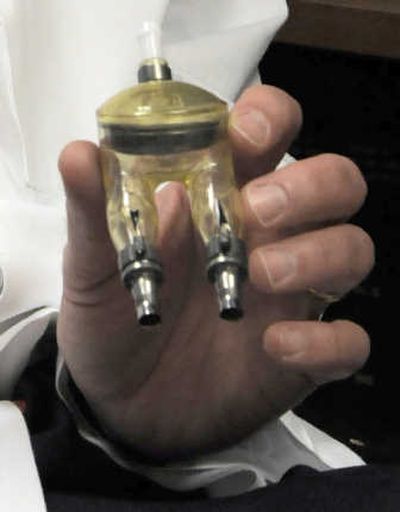Doctors want more medical implants tailored for kids

WASHINGTON – It took a metal plate improperly lodged in a young boy’s skull to make Dr. David Staffenberg realize just how dangerous adult-sized devices can be in children.
The plate was implanted to help stabilize the boy’s skull but ended up resting on his brain. While Staffenberg was able to safely remove the titanium disc, the fact that he was faced with this added risk speaks to a problem pediatricians face every day: the vast majority of medical devices are made for adults.
Doctors work around the problem by jury-rigging adult-sized devices to suit their needs. But they acknowledge that such ingenuity has limits and that the risks to patients are often high. With growing support from lawmakers, doctors are prodding the medical device industry to design a new class of kid-friendly equipment.
A law signed by President Bush in September offers financial incentives to companies that design devices for kids. It also gives regulators more power to scrutinize the use of adult-sized devices in children and requires manufacturers to bear the costs of tracking them.
While this added oversight has dampened industry’s enthusiasm for the law, there are other more practical reasons device makers remain cautious about jump-starting production.
The profit potential is limited because the law allows experimental kid-sized devices to be sold without full federal approval only if they’re used to treat rare diseases. Also, compared to adults, kids are healthier, and therefore a much smaller market to begin with.
“The pediatric market is a mere fraction of the market for adults,” said Paul Citron, who recently retired as vice president of technology at device maker Medtronic Inc. While the U.S. market for medical devices is estimated at nearly $90 billion, health care experts agreed the pediatric portion of that is minuscule.
And with companies like Medtronic and Boston Scientific Corp. already under scrutiny for pacemakers, stents and other adult devices, they may be more reluctant to start testing in kids.
Child-safety proponents and parent groups have largely stayed out the debate, preferring doctors take the risks of working with less-than-ideal tools rather than do nothing.
But as the use of devices has increased, so have complaints from physicians. Shortcomings include:
•heart valves that quickly deteriorate in growing bodies.
•heart-shocking pacemakers that cause infection, stroke and death in small patients.
•surgical cameras that damage tissue in children because they are too big.
The Food and Drug Administration, which regulates devices, has almost no data on how widely adult devices are used in children. The only large scale study of this issue, conducted in 2005 by the Institute of Medicine, yielded no estimate on how many deaths or injuries result from the practice, though doctors say there have likely been some of each.
Problems range from the mundane – oversized oxygen masks – to the complicated – pacemaker batteries that run out because of children’s faster heartbeats. And some, like a metal plate lodged in a growing skull, could cause seizures or more serious problems if untreated.
“It seems so obvious, but babies and children are not simply little adults,” said Staffenberg. “There is a fourth dimension to treating them because they are still growing.”
To be sure, a steady trickle of pediatric devices has made it to the market. Device maker Respironics has built an entire subsidiary around respiratory equipment for hospitalized babies, a relatively large market. Last year, German device firm Berlin Heart began U.S. testing of the first heart pump for infants awaiting transplant.
Dr. James Lock, head of cardiology at Children’s Hospital Boston, said 98 percent of the devices he has in the operating room are designed for adults. One of the few pediatric devices he uses, a cloth patch to seal tiny holes between heart chambers, is one he invented himself.
Lock finally persuaded NMT Medical to manufacture his Cardioseal after studies suggested an alternate use in adults. The Boston-based company would never have built the seal without discovering a market “potentially 20 times larger than the pediatric market,” Lock said.
In pediatric heart surgery, Lock uses a doctor-modified covered stent to plug tears in the aorta. The stent, a metal-mesh tube, is designed for adult liver surgery. Since no U.S. company makes a covered stent for children, Lock hand sews cloth coverings onto the adult ones.
But Lock and other physicians acknowledge their ingenuity often falls short.
“Are there times you can’t do a procedure you need to because the device isn’t designed for the indication?” asked Lock. “Yes, that happens a fair amount.”
After thousands of doctors made similar complaints, the American Academy of Pediatrics boosted its lobbying budget by more than 100 percent to $362,500 in 2007 to help pass legislation on pediatric-device development.
But even if the new law does clear some hurdles needed to test devices in children, manufacturers say they lack the technology to give doctors what they want.
Instead, device companies keep their development sights on seniors, leaving much of the research in the pediatric field to nonprofits and academics. The device bill proposed $30 million in research grants over five years, but none has been set aside in the federal budget.